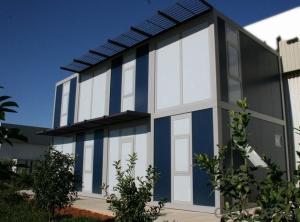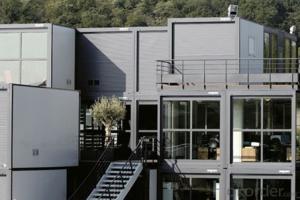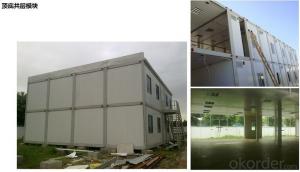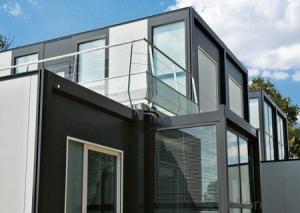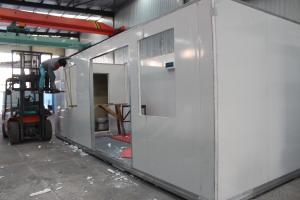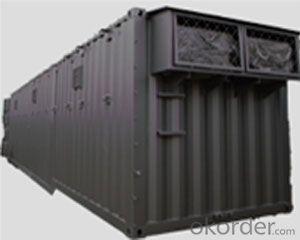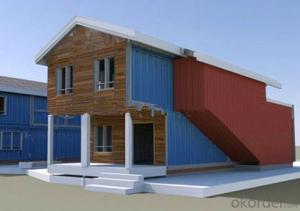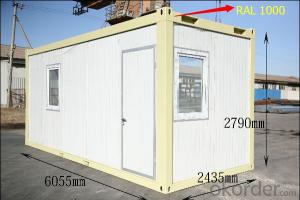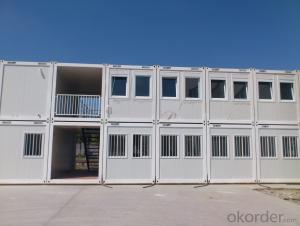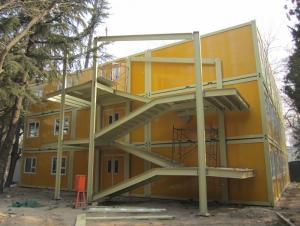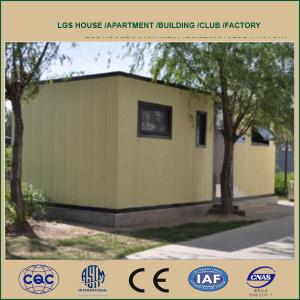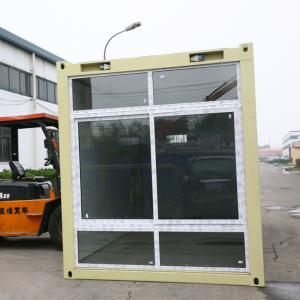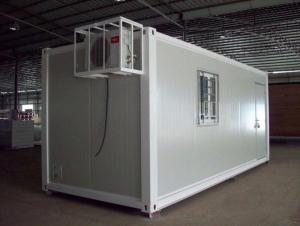Low cost container house for building
- Loading Port:
- China Main Port
- Payment Terms:
- TT OR LC
- Min Order Qty:
- -
- Supply Capability:
- -
OKorder Service Pledge
OKorder Financial Service
You Might Also Like
Our advantages:
1. Qualification: CE(DIN18800), ISO9001, BV
2. Durable, beautiful, economic and environmental
3. High Construction Efficiency (2 worker in one day for one unit)
4. Long life time (Max. 20 years)
5. Easy to transport and assemble (Can load 7 units into one 40'HQ)
Brand Name: PTH
Our advantages:
1) Integrated base and roof, PU injected, excellent strength and tightness
2) 0.426mm color steel sheet for sandwich wall panel, strong and beautiful
3) All electric wires, water pipes, windows, doors and floor pre-setted, easy for assembling
4) Long time oversea project experience
5) 4S sales and service network, buy a house just like to buy a car
| standard | roof load | 0.5KN/sqm (can reinforce the structure as required) |
| Wind speed | designing wind speed: 210km/h (Chinese standard) | |
| seismic resistance | magnitudes 8 | |
| temperature | suitable temperature.-50°C~+50°C |
Usage: The small container house has the following features: light weight, convenient and fast assembling and shipment, many-times disassembling, high rate of reuse. It can be applied to office, command posts, dormitories, meeting rooms, warehouses, shops, additional storey on building roof and temporary houses in the field of building, railways, highways, water conservancy projects, electric power, oil, business, tourism, and military use. And the houses are air-tight, heat-insulating, warm-keeping, waterproof and anti-corrosive.
1. Easy to assemble and disassemble: The houses can be assembled and disassembled for dozens of times and can be reused for many times. And the assembling only needs simple tools and doesn’t need power source. The connections of the pieces of the house all adopt plugs or screw connections.
2. Strong Structure: It adopts steel frame structure, therefore it is stable and in line with the designing code of building structure.
3. Heat-insulation: The roof and wall are made of color steel sandwich panel (EPS, XPS, PU or Rock Wool) which have good heat-insulating and fire-proof performance.
4. Durable: The steel frame parts are all processed with anti-corrosion coating and it can be used as long as 20 years.
5. Environment protection: The design of the house is reasonable and it is easy to assemble and disassemble.
6. Diversified Specifications: Our design can be customized. The doors, windows and front and back walls can be exchanged each other. And the partition walls according to the customers’ requirements.
- Q: Can container houses be designed with a rooftop deck or terrace?
- Container houses can indeed have a rooftop deck or terrace. The use of shipping containers as building units offers numerous benefits, including their inherent strength and versatility, enabling the creation of innovative designs. By utilizing the container's flat roof surface, it can be transformed into an outdoor living area like a deck or terrace. This provides homeowners with extra usable space to enjoy outdoor activities and take in panoramic views. However, it is crucial to consider the structural implications and ensure that the container house is properly designed and reinforced to support the added weight and stress of a rooftop deck or terrace.
- Q: Are container houses suitable for low-income housing projects?
- Container houses are indeed a viable option for low-income housing endeavors. Due to their utilization of recycled shipping containers, they prove to be cost-effective, resulting in reduced construction expenses. This enables swifter implementation of these projects, catering to the urgent requirement for low-income housing. Moreover, container houses demonstrate flexibility, easily adaptable to meet the distinctive necessities and preferences of various communities. They can incorporate vital facilities such as plumbing, electricity, and insulation, thus ensuring a secure and comfortable living environment for those with limited financial resources. Furthermore, container houses contribute to environmental sustainability by repurposing existing materials, making them eco-friendly. Ultimately, container houses provide an economical and pragmatic solution for low-income housing initiatives, rendering them a suitable choice to tackle the housing needs of underprivileged communities.
- Q: Can container houses withstand extreme weather conditions?
- Yes, container houses are designed to withstand extreme weather conditions. These houses are typically made from steel shipping containers, which are built to be extremely durable and resistant to harsh environments. They are constructed to withstand heavy loads, such as being stacked on top of each other during transport, and are also designed to resist the impacts of rough seas and strong winds. Container houses can be modified to enhance their ability to withstand extreme weather conditions. For instance, insulation can be added to regulate temperature and prevent heat loss during cold winters or excessive heat in hot summers. Additionally, reinforced windows and doors can be installed to provide extra protection against strong winds and storms. Furthermore, container houses can be designed to be resistant to flooding by elevating them on stilts or using a raised foundation. This helps to minimize the risk of water damage during heavy rainfall or flooding events. Overall, while no structure is completely impervious to extreme weather, container houses are specifically engineered to be robust and durable, making them well-suited to withstand a wide range of weather conditions.
- Q: Can container houses be designed with a built-in workspace or study area?
- Yes, container houses can definitely be designed with a built-in workspace or study area. One of the advantages of container houses is their versatility and adaptability in design. With proper planning and customization, it is entirely possible to incorporate a dedicated workspace or study area into a container house design. There are several ways to achieve this. Firstly, the layout of the container house can be carefully designed to allocate a specific area for a workspace or study. This can be achieved by dividing the available space into different sections, ensuring that there is enough room for a desk, chair, and storage for books or study materials. Additionally, container houses can be modified with additional windows or skylights to allow ample natural light into the workspace or study area, creating a pleasant and conducive environment for work or study. Adequate electrical outlets and internet connectivity can also be installed to ensure functionality and productivity in the workspace. Furthermore, container houses can be designed with built-in storage solutions, such as shelves, cabinets, or drawers, to keep the workspace organized and clutter-free. This will help maximize the available space and create a productive atmosphere. Ultimately, the design of a container house with a built-in workspace or study area depends on the specific needs and preferences of the individual or family. With careful planning, creative design solutions, and customization options, container houses can be transformed into comfortable and functional spaces that cater to both living and working/studying requirements.
- Q: Are container houses suitable for religious or spiritual centers?
- Indeed, container houses are a suitable choice for religious or spiritual centers. They possess various advantages that render them a feasible option for such establishments. Primarily, container houses are economically efficient, enabling religious or spiritual centers to make the most of their limited resources. As these centers often rely on community donations and funds, being able to construct a functional space at a fraction of the cost of traditional construction is extremely advantageous. Moreover, container houses are adaptable and can be tailored to meet the specific requirements and aesthetic preferences of religious or spiritual centers. Whether it be a meditation room, a chapel, or a meeting area, container houses can be easily altered to create a tranquil and sacred environment. Additionally, container houses are eco-friendly and sustainable. Many religious or spiritual centers emphasize the significance of environmental conservation, and utilizing repurposed shipping containers aligns perfectly with these values. By incorporating renewable energy sources and efficient insulation systems in their container houses, these centers can further enhance their commitment to sustainability. Furthermore, container houses offer flexibility in terms of location. Religious or spiritual centers can be established in remote or temporary areas, and container houses can be effortlessly transported and installed in these locations. This enables these centers to cater to communities that may not have access to traditional religious or spiritual spaces. In conclusion, container houses offer religious or spiritual centers cost-effective, customizable, sustainable, and flexible options for their facilities. By utilizing container houses, these centers can create sacred spaces that align with their values while efficiently utilizing available resources.
- Q: Are container houses considered a sustainable housing option?
- Yes, container houses are considered a sustainable housing option. They are made from recycled shipping containers, reducing waste and utilizing existing resources. Additionally, their construction process requires less energy and materials compared to traditional houses. Container houses can also be designed to incorporate eco-friendly features such as solar panels, rainwater harvesting systems, and insulation for energy efficiency. Overall, container houses offer an environmentally conscious and sustainable alternative for housing.
- Q: Can container houses be built with sustainable materials?
- Certainly, sustainable materials can indeed be used to construct container houses. The utilization of shipping containers as the foundation for homes is already an environmentally conscious approach, as it repurposes these steel structures that would otherwise be wasted. Furthermore, sustainable materials can be integrated into the construction of container houses to further enhance their eco-friendliness. For instance, container walls, floors, and ceilings can be insulated using sustainable insulation materials like recycled denim, cellulose, or wool. This insulation reduces the energy required for heating and cooling. Additionally, renewable and low-impact flooring options such as bamboo or cork can be employed. Windows and doors made from recycled materials, which are energy-efficient, can be installed. Moreover, the use of low-VOC paints and finishes can improve indoor air quality. Furthermore, container houses can become more self-sufficient and reduce reliance on fossil fuels by incorporating renewable energy systems like solar panels. Rainwater harvesting systems can also be implemented to collect and reuse water, thereby reducing water consumption and lessening the strain on local water sources. Through the adoption of these sustainable materials and practices, container houses can significantly decrease their environmental impact and contribute to a more sustainable and eco-friendly housing solution.
- Q: Can container houses be built in coastal areas?
- Container houses can indeed be constructed in coastal areas. These houses are fashioned from shipping containers, which are specifically designed to endure harsh conditions such as strong winds, saltwater, and corrosion. This makes them well-suited for coastal environments where exposure to saltwater, powerful winds, and other weather elements is likely. However, it is crucial to take specific precautions when erecting container houses in coastal regions. For instance, employing proper insulation and ensuring thorough sealing of the containers can safeguard them from the corrosive effects of saltwater. Moreover, it is essential to utilize appropriate foundation and anchoring systems to guarantee stability and resistance against forceful winds and potential flooding. By implementing these measures, container houses can be a practical and long-lasting housing option in coastal areas.
- Q: Are container houses suitable for artist residencies?
- Yes, container houses can be highly suitable for artist residencies. Container houses offer several advantages that make them a great option for artists looking for a space to live and work in during their residency. Firstly, container houses are affordable and can be easily customized to meet the specific needs of artists. They provide a cost-effective alternative to traditional housing options, allowing artists to allocate more of their resources towards their artistic pursuits. Secondly, container houses are highly flexible and can be easily moved or transported to different locations. This makes them ideal for artists who want to experience different environments and seek inspiration from diverse settings. Artists can engage in residencies in various locations without having to worry about finding new accommodations each time. Additionally, container houses are known for their sustainability and environmental friendliness. Many artists value sustainability and are conscious of their carbon footprint, making container houses a perfect fit for their ethos. These houses can be built using recycled materials and can incorporate green technologies, such as solar panels or rainwater collection systems. Furthermore, container houses offer a unique and unconventional aesthetic that can inspire creativity. Artists often search for spaces that facilitate their artistic process and provide an environment that sparks their imagination. Container houses, with their modern and industrial look, can serve as a blank canvas for artists to transform and personalize according to their artistic vision. Lastly, container houses can provide the necessary amenities and functional spaces needed for art creation. They can be easily modified to include spacious studios, ample storage, and living areas that can be adapted to accommodate various art forms. Artists can have everything they need within their living space, allowing them to fully immerse themselves in their work. In conclusion, container houses are highly suitable for artist residencies due to their affordability, flexibility, sustainability, unique aesthetic, and ability to meet the functional requirements of artists. These houses provide a conducive and inspiring environment for artists to live, create, and explore their artistic potential.
- Q: Are container houses suitable for remote work or telecommuting?
- Yes, container houses can be suitable for remote work or telecommuting. Container houses are often designed to be versatile and can be customized to create a comfortable and functional workspace. With proper insulation, heating, cooling, and ventilation systems, container houses can provide a conducive environment for remote work. Container houses can be easily modified to include dedicated office spaces or workstations, equipped with all the necessary amenities like desks, chairs, shelving, and storage. Additionally, they can be designed to have sufficient natural light and views to create a pleasant working atmosphere. One of the advantages of container houses is their portability. They can be transported to remote locations, allowing individuals to work from anywhere they desire. This flexibility is beneficial for those who prefer a change of scenery or need to move frequently for work. Furthermore, container houses are often cost-effective compared to traditional houses, making them an attractive option for remote workers who are looking to save on housing expenses. They require less maintenance and can be more energy-efficient, reducing utility costs. However, it's important to consider some limitations of container houses for remote work. The limited space in container houses may not be suitable for individuals who require a large workspace or have specific equipment needs. Additionally, the noise insulation might not be as effective as in traditional houses, which can be a concern if the remote work involves frequent online meetings or conference calls. In conclusion, container houses can be an excellent choice for remote work or telecommuting due to their versatility, affordability, and portability. With proper modifications, they can provide a comfortable and functional workspace, allowing individuals to work remotely in a unique and sustainable environment.
Send your message to us
Low cost container house for building
- Loading Port:
- China Main Port
- Payment Terms:
- TT OR LC
- Min Order Qty:
- -
- Supply Capability:
- -
OKorder Service Pledge
OKorder Financial Service
Similar products
Hot products
Hot Searches
Related keywords
